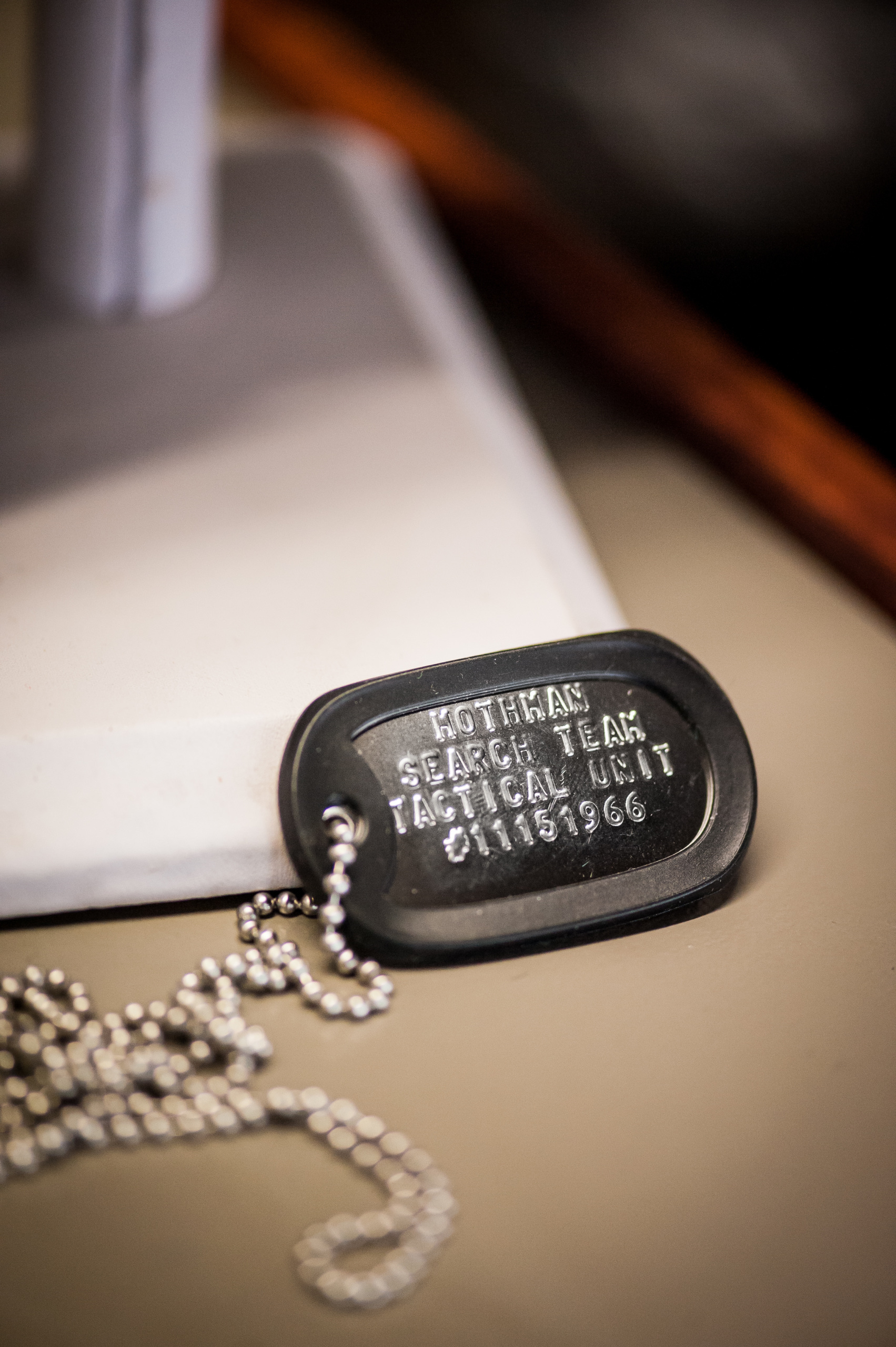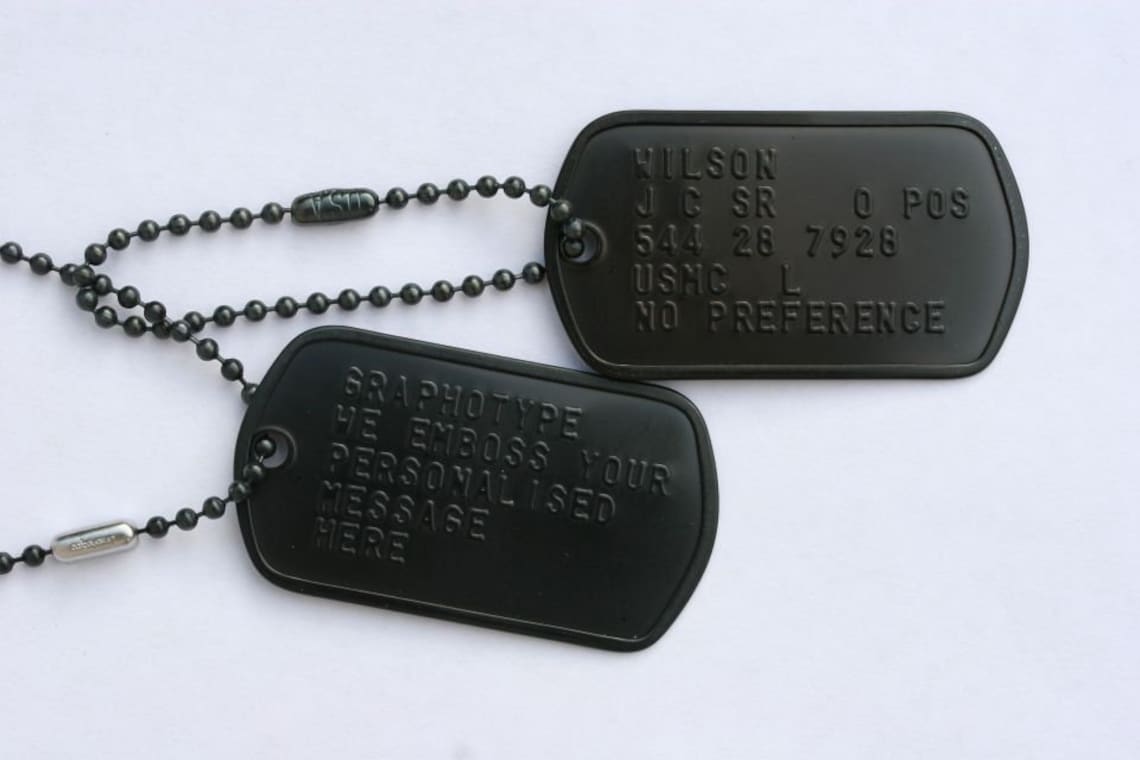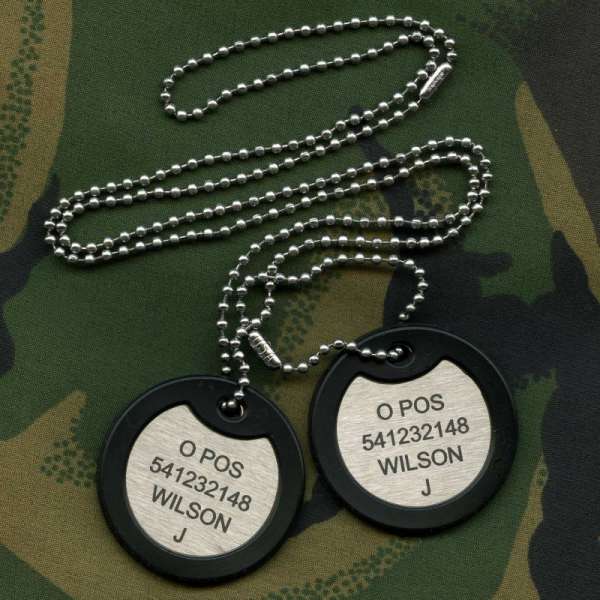


- #ARMY DOG TAGS SERIAL NUMBERS#
- #ARMY DOG TAGS SERIAL NUMBER#
- #ARMY DOG TAGS MANUAL#
- #ARMY DOG TAGS FULL#
3rd to 5th Lines - Address of next of kin and on the 5th line and to the right an initial indicating the soldier’s religion.
#ARMY DOG TAGS FULL#
The dog tags were marked in the following manner: 1st Line - soldier’s full name, 2nd Line - his full seven or eight digit service number and date of any Tetanus injections (e.g., T42 or T41 42) an initial to indicate blood group.
#ARMY DOG TAGS MANUAL#
The new stainless steel tags were embossed with letters and numbers from a manual or electric machine that resembled an oversized typewriter. In 1940, the Army introduced a “notched” rounded-end rectangular tag and is referred as the M1940 identification Tag. In October of 1938 the start of tests for a new identification tags started, and by 1940 it was adopted. First made of brass and then a "Monel" metal (a patented corrosion-resistant alloy of nickel and copper, melted with small amounts of iron and manganese) proved to be more corrosion resistant. Next in the evolution of dog tags came what is known as the Navy/Marine style a more oblong shape with more uniform printing.
#ARMY DOG TAGS SERIAL NUMBERS#
In February of 1918 the official introduction of Serial Numbers started. In July of 1916 a second tag was added, and by 1917 all combat troops wore aluminum discs on rope or chain. Pierce recommended that a "identity disc" be included in the standard combat field kit, though the first official introduction didn't happen until December of 1906.The Army Regulations of 1913 made a identification tag mandatory. The first official advocacy of issuing a ID tag took place in 1899. Soldiers also fashioned coins by scraping one side smooth and engraving or stamping name and unit. Some troops made their own ID s out of wood, boring a hole in the end so that they could be worn on a string. Many soldiers took great care in marking all of their personal belongings. In 1863, before the battle of Mines Run in northern Virginia, troops wrote their names and units on a paper tag and pinned them to their clothing. Their identification tags methods varied, and all were taken on by the soldier's own initiative. The history of American Civil War (1861-65) provided the first recorded incident of soldiers making an effort to ensure that their identification would be known should they be killed on the battlefield. As a result, it became a practice for soldiers on both sides to pin a handkerchief or piece of paper with their names and addresses to their uniforms just before battle. The carnage was so great and bodies were so disfigured that they sometimes could not be identified (history tells us that 40% of all Civil War dead remain unknown).

*Special Thanks to Brad LaGrange and Lee Russel for providing the above information on service numbers.The history behind military identification tags, commonly known as "dog tags," originated during the Civil War. During this time, if you have no religious preference, the tags are typically stamped "NO PREFERENCE" or left blank. You also see many tags with specific main stream denominations such as Baptist, Presbyterian, Methodist, etc. For Vietnam Era tags, you also see the use of the "broad" religions such as Catholic, Protestant, Hebrew fully spelled out as opposed to the first letter on WWII tags. After this date the Social Security Number was used exclusively. From this time until June 1969, many dog tags used both numbers.
#ARMY DOG TAGS SERIAL NUMBER#
The Army used the Army Serial Number exclusively until the end of 1967 when the use of Social Security Numbers (9 digits) was introduced. Of interest, is that US67 numbers indicated one of McNamara's Project 100,000 draftees who had failed the Armed Forces minimal IQ test, but were drafted anyway to meet the manpower needs. 0 indicated outside the US such as Puerto Rico, Virgin Islands, or America Samoa. 1 or 2 indicated Northeast (after the 2nd Army was absorbed by the 1st Army in the 50's), 3 South, 4 Southwest, 5 Mid-West, 6 California, Pacific Coast, Hawaii, Alaska. The second number is the "Army Area" the draftee was from. 6 was considered a bad number as it was reserved for the "Project 100,000". When using draftee designation "US", the first number is either a 5 or a 6. The Army Service Number was 8 digits and had one of the following prefixes: RA (Regular Army, volunteer enlisted), US (an enlisted draftee), NG (National Guard), ER (Enlisted Reserve), O (Officer).


 0 kommentar(er)
0 kommentar(er)
